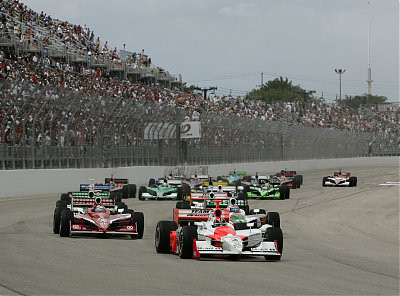The Way It Is/ The importance of continuity and stability
by Gordon Kirby I've written a considerable amount about how important the technical rules and new formula for 2011 are to the hoped-for revival of Indy car racing. But of course there's another, equally important element and that is the schedule and venues. In fact, some people will argue this factor is even more important than the technical formula.
I've written a considerable amount about how important the technical rules and new formula for 2011 are to the hoped-for revival of Indy car racing. But of course there's another, equally important element and that is the schedule and venues. In fact, some people will argue this factor is even more important than the technical formula.
To present the greatest challenge for the drivers and teams, a correct mix is required of ovals, road courses and street circuits. The proper combination of tracks and events also would provide the optimum blend of markets, audiences and demographics, and I'm one of many who believe that for ten or fifteen years CART had the right mixture of races--one-third ovals, one-third road courses, and one-third street circuits.
As CART discovered in the eighties and nineties, and Tony George and the IRL rediscovered in recent years, it's essential to Indy car racing's success to have as broad a mix of races as possible. Road courses and street circuits attract different, wider audiences than ovals and, as everyone knows, a properly-designed and operated street racing event provides the best setting for corporate hospitality, entertainment and sponsorship sales.
It's also true, as Mario Andretti has long maintained, that the more oval races on the schedule, the more costly the season. That's simply because big crashes are more frequent on ovals and more damaging to the equipment and sometimes to the driver, too.
Another point I agree with Mario about is that the perfect mix would include three 500-mile races on big speedways and a handful of other oval races on short, flat tracks--classic venues like Milwaukee and Phoenix. Since Daytona opened in 1959, history has proven repeatedly that high-banked ovals are too fast and too dangerous for Indy cars. These tracks were built for stock cars but even those beasts have reached the outer limits on high-banked tracks, witness the introduction of restrictor plates by NASCAR twenty years ago.

© LAT USA
Personally, my ideal IRL schedule would include St. Petersburg, Long Beach, Motegi, Houston, Laguna Seca, Indianapolis, Milwaukee, Michigan, Cleveland, St. Jovite, Toronto, Watkins Glen, Mid-Ohio, Elkhart Lake, Portland, Phoenix, Mexico City and Surfers Paradise. The problem, as ever, isn't finding enough road courses or street circuits to put on successful races. It's finding the right kind of ovals for Indy cars to race on safely and effectively and produce real, money-making events.
Most important of all is settling on a solid schedule of races and then sticking with it. A stable schedule would allow each event to build continuity and date equity--all-important items in making any sporting event successful. Many people forget that NASCAR prepared for its recent boom by sticking to a darn near unchanged schedule and building its fans base and audience slowly, almost stealthily, over a quarter of a century through the seventies, eighties and nineties.
Meanwhile, each of IRL, CART and Champ Car struck a stark contrast with incredibly unstable, changing schedules. From 2000 through last year, CART/Champ Car burned through no fewer than twenty-three different venues while the IRL went through a dozen tracks. Depending on which ex-Champ Car races come back to life next year, as many as ten more venues could be added to this sad list of spurned tracks! Any racing series with such a disgusting record of contempt for the fans, as well the burned business bridges, deserves to fail.
This pathetic, recent history beggars belief and it bears running through the list of CART/Champ Car's lost races in chronological order from 2000. Here it is: Homestead, Rio de Janeiro, St. Louis, Nazareth, Detroit, Houston 1, Michigan, Motegi, Brands Hatch, the Lausitzring, Miami (street circuit), Mid-Ohio, Chicago, Rockingham (UK), California Speedway, Vancouver, Laguna Seca, Las Vegas Speedway, Monterrey, Denver, Montreal, Las Vegas (street circuit), and San Jose. And in danger of not being revived in 2009 are Laguna Seca, Portland, Elkhart Lake, St. Jovite, Mexico City, Zolder and Assen.
For its part, the IRL tried racing at the following tracks but after a few years were told 'Sayonara' by the promoters: Orlando, New Hampshire, Las Vegas Speedway, Phoenix, Charlotte, Dover, Atlanta, Pike's Peak, St Louis, Nazareth, California Speedway and Michigan. Some of these--New Hampshire, Las Vegas, St. Louis, Nazareth, California and Michigan Speedways--were CART cast-offs that struggled for a few years as IRL races. Also among these are Homestead which continues on the IRL schedule and Detroit which was revived last year by Roger Penske.
The fall-out from all this chopping and changing is that few people--fans, promoters, sponsors and media--have any faith or belief in Indy car racing. So whatever decisions the IRL makes about its 2009 schedule, it must then demonstrate its commitment to stability and continuity. The schedule needs to remain firmly committed for many years because that's the only way to build equity in each market and rebuild the fan and media following locally, nationally and around the world.
Auto Racing ~ Gordon Kirby
Copyright 2008 ~ All Rights Reserved
Copyright 2008 ~ All Rights Reserved
Top of Page